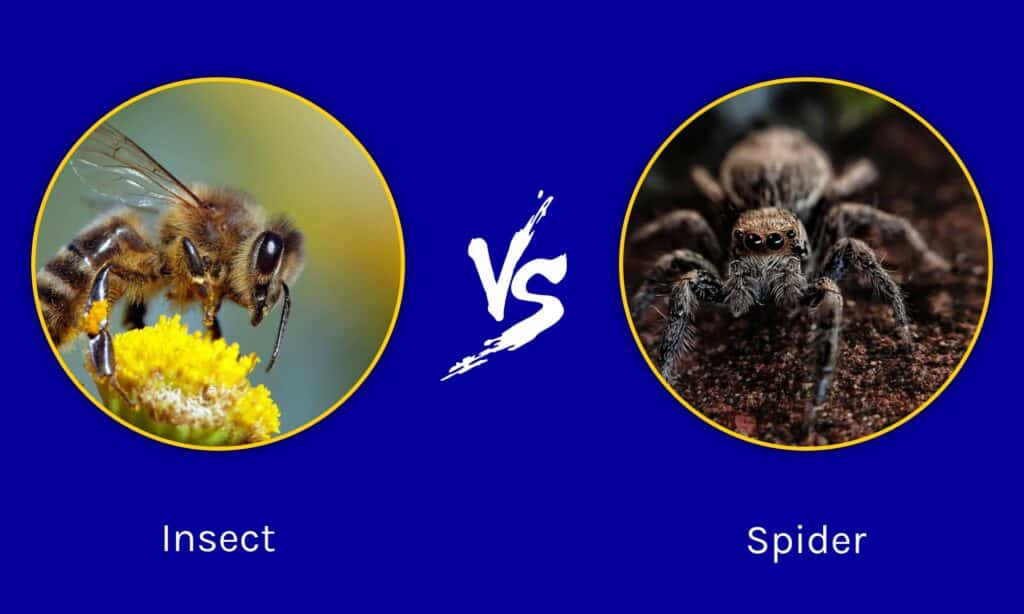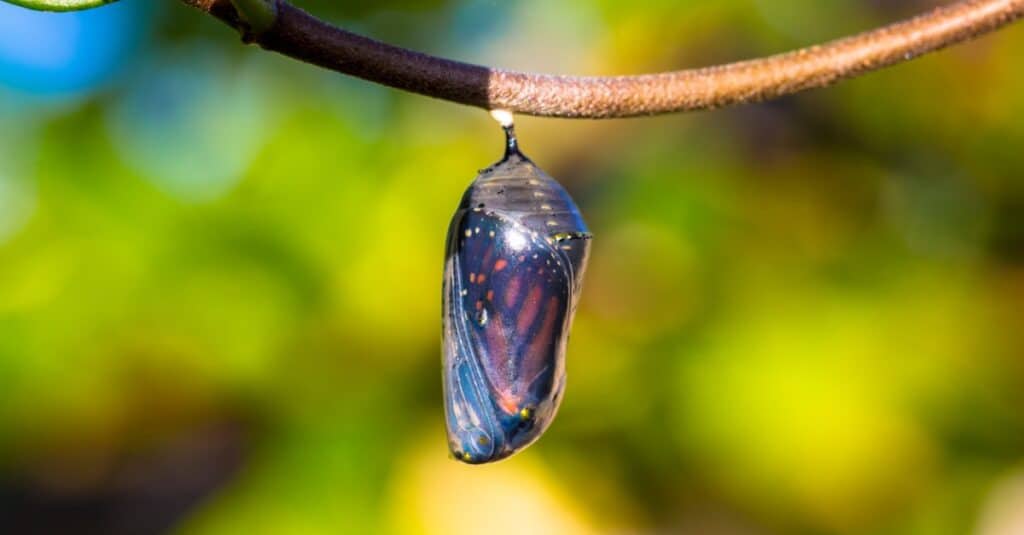Spiders are eight-legged creatures that give many people creeps. However, they are not insects. Unlike the situation with bugs and insects, this is not merely a case of spiders being a part of a different phylogenetic order. Insects and spiders are from separate phylogenetic classes. Today, we’re going to illustrate the biggest differences between insects vs spiders by comparing and contrasting each on three significant levels.
When we are finished explaining the differences, you’ll know everything you need to differentiate these creatures. Let’s get started by performing a basic comparison of insects and spiders.
Comparing Insects vs Spiders

| Insects | Spiders | |
|---|---|---|
| Scientific Classification | – Arthropoda phylum – Insecta class | – Arthropoda phylum – Arachnida class – Araneae order |
| Metamorphosis | – May undergo full metamorphosis or incomplete metamorphosis – Most undergo metamorphosis in a four-stage lifecycle of egg, larva, pupa, adults – Incomplete metamorphosis requires molting to take place for growth | – Incomplete metamorphosis (gradual metamorphosis) – Develops from an egg to a spiderling and finally into an adult |
| Morphology | – Three sections of their body, a head, thorax, and abdomen – Possess three pairs of jointed legs – Two antennae – Chitinous exoskeleton – Two pairs of wings, when present – Compound eyes containing multiple lenses | – Has a two-section body with a cephalothorax (includes head and thorax) and an abdomen – Possesses eight legs – Many possess silk-producing spinnerets – Has an exoskeleton made of chitin – Mouths include chelicerae, jaws that may be pincers or fangs that help them inject venom into prey – Also have pedipalps that help capture meals and eat food – Lack of compound eyes – Possesses 6 to 8 simple eyes |
| Examples | – Bees, flies, beetles, dragonflies, | – Tarantula, black widow, brown recluse, hobo spiders |
The Key Differences Between Insects and Spiders
The greatest differences between insects and spiders lie in their morphology and scientific classification. Insects belong to the Arthropoda phylum and Insecta class, and they are known for having three segments to their body, three pairs of jointed legs, a chitinous exoskeleton, and compound eyes. Spiders are members of the Arthropoda phylum and Arachnida class. They have a two-section body, eight legs, a chitinous exoskeleton, unique mouthparts, simple eyes, and the ability to spin silk and inject venom.
Although the types of creatures have some similarities, the fact is that they have a great number of differences, too. With that in mind, we’re going to go deeper into these comparisons to demonstrate the uniqueness of these two classes.
Insects vs Spiders: Scientific Classification

Spiders belong to the
Arachnidaclass.
©Decha Thapanya/Shutterstock.com
Both insects and spiders are part of the Arthropoda phylum, but they do not belong to the same class. On one hand, you will find that insects belong to the Insecta class. On the other hand, you will discover that spiders belong to the Arachnida class and the Araneae order.
These two groups of creatures may have some similarities in their bodies because they belong to the same phylum. However, their differences are profound as demonstrated by their phylogenetic differentiation.
Insects vs Spiders: Metamorphosis

Insects can undergo either complete or incomplete metamorphosis.
©iStock.com/Daynjer-In-Focus
A major difference between insects and spiders is the way they undergo metamorphosis. Insects either undergo a complete or incomplete metamorphosis. The incomplete metamorphosis is also known as a gradual metamorphosis, and that is the only sort that spiders can perform.
The most common example of an insect undergoing complete metamorphosis is the caterpillar. A caterpillar will hatch from an egg into its larva form. This larva will spend a lot of its time eating food to prepare for the next stage of metamorphosis. In the meantime, the caterpillar will molt several times and increase its size.
Once the caterpillar has reached a certain stage in its life, it finds a suitable area and enters the next phase as a pupa. The insect either spits from its exoskeleton into a chrysalis or spins a cocoon. During the pupa stage, the creature breaks down almost entirely and forms a new body structure. Over the next few days or months, a butterfly or moth forms and emerges into its fourth, final adult form.
Spiders do not go through such a complicated form of metamorphosis. Instead, they emerge from their eggs as spiderlings. These creatures undergo a gradual or incomplete metamorphosis by molting their exoskeleton until they reach their adult size.
In short, some insects can undergo a gradual metamorphosis or a full metamorphosis, but spiders only under a gradual metamorphosis.
Insects vs Spiders: Morphology

The majority of adult insects have six legs, three segments of their body, and a chitinous exoskeleton.
©iStock.com/KarelGallas
Insects and spiders have very specific and unique bodies. Insects have three sections to their body, including the head, thorax, and abdomen. However, spiders only have two sections to their bodies, the cephalothorax and the abdomen. The former section is a fused head and thorax.
Insects have three pairs of jointed legs, giving them a total of six. However, spiders have eight legs, four on each side of their body. Both creatures have chitinous exoskeletons, and that is perhaps the greatest similarity in their bodies.
After all, many insects have wings that allow them to take flight, two antennae, and compound eyes. Spiders can’t fly without the aid of their silk balloons and the right amount of wind, thankfully. Moreover, spiders have no antennae, and they only possess between four and eight simple eyes instead of compound eyes.
That doesn’t mean spiders are less capable or developed, though. They have many unique body parts, including their spinnerets that help them produce silk for webs to trap prey. Spiders also have chelicerae and pedipalps that help them manipulate food items and envenomate their prey.
The world has many venomous spiders that are incredibly capable hunters as a result of their bodies’ adaptations.
All in all, insects and spiders are similar in some respects, but they are different in most. Their bodies, classification, and the way they undergo metamorphosis are all distinct. So, the next time someone calls a spider an insect or a bug, you’ll know better. After all, spiders aren’t even in the same class as insects, and they are certainly not bugs, either.
The photo featured at the top of this post is © Daniel Prudek/Shutterstock.com
Thank you for reading! Have some feedback for us? Contact the AZ Animals editorial team.






